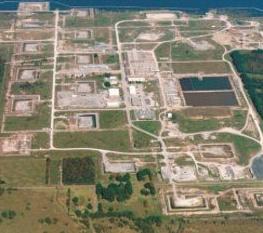This week, a Curious Louisiana reader's attention has turned subterranean.
"Are oil reserves really stored in south Louisiana salt domes?" they ask.
Are they ever.
Since October 1977, emergency crude oil has been stored at the Strategic Petroleum Reserve in four sites along the Gulf Coast. Known as the world's largest supply of emergency crude oil, the reserves were created in the wake of the 1973 oil crisis with the overall aim of helping in the event of future oil supply disruptions.
Two of the sites, Bryan Mound and Big Hill, are in Texas. Another two, West Hackberry and Bayou Choctaw, are in Louisiana.
Both Louisiana sites were acquired in April 1977. Bayou Choctaw is in Iberville Parish, approximately 12 miles southwest of Baton Rouge, and it became operational in 1987. It has six storage caverns with an authorized storage capacity of 76 million barrels of oil.

The West Hackberry Strategic Petroleum Reserve is a crude oil storage site in Cameron Parish. It has 21 different storage caverns with total capacity of 220.4 million barrels.
West Hackberry is located in Cameron Parish, approximately 25 miles southwest of Lake Charles. It became operational slightly later, in 1988, and has 21 storage caverns with an authorized storage capacity of 220.4 million barrels of oil.
Up until 1994, there was a third site in Louisiana. The Weeks Island site was a former Morton Salt mine over half a mile wide and around 700 feet below sea level. Though it could hold more than 72 million barrels of oil, subsidence issues plagued it throughout its existence and a sinkhole in 1993 led to the site being decommissioned.
According to the Office of Cybersecurity, Energy Security and Emergency Response, the caverns were picked for their location, security and affordability. They cost, in the website's words, "up to 10 times less than above ground tanks and 20 times less than hard rock mines."
"Besides being the lowest-cost way to store oil for long periods of time, the use of deep salt caverns is also one of the most environmentally secure," the CESER's website reads.
"Rock salt exhibits extremely low porosity and permeability, plastic deformation characteristics, and self-healing characteristics, at the subsurface depths that the caverns are located. It is these self-healing characteristics which will almost instantly close any microcracks, should they develop in the walls of the salt caverns."
Gary Kinsland, a professor emeritus at the University of Louisiana at Lafayette's School of Geosciences, said salt domes had been used internationally for a very long time. Salt's sealing properties mean underground domes don't need to be lined with other materials to prevent seepage.
"If you think about glaciers, and the way they slowly flow, salt does the same thing," he said. "That ability to flow allows it to be really good at sealing. You're not going to get a flow through it, even if you're dealing with something like natural gas."
That's not to say they're bulletproof. Kinsland points to Weeks Island's failings, and the collapsed salt dome that led to the Bayou Corne disaster, as examples of what can happen. However, accidents are uncommon, with salt's natural sealing properties preventing environmental catastrophe.
"In Europe, natural gas is commonly stored in salt domes. It's pumped in under pressure during summer and let out during winter, and they have a very long history of doing that safely. (Having an accident) is a rare kind of thing."
Kinsland said it was "hard to imagine" just how big the underground domes are. To get a bit of perspective, one collapse sucked down an entire drilling rig and nine or 10 barges (all but one of which later popped back up).
The SPR sites have a combined capacity of around 714 million barrels, though the actual amount in them has waxed and waned over the years. The highest inventory was 726.6 million barrels, reached in December 2009; the most recent figures, from October last year, show the sites to contain 351.2 million barrels.
The reasons for the fluctuations include natural events — especially hurricanes — and political decisions. The Biden administration controversially sold more than 40% of the reserve in 2022 to help stall rising fuel prices; plans to replenish the stocks have so far been delayed by continued high prices. The reserves are currently near their lowest level in 40 years.



